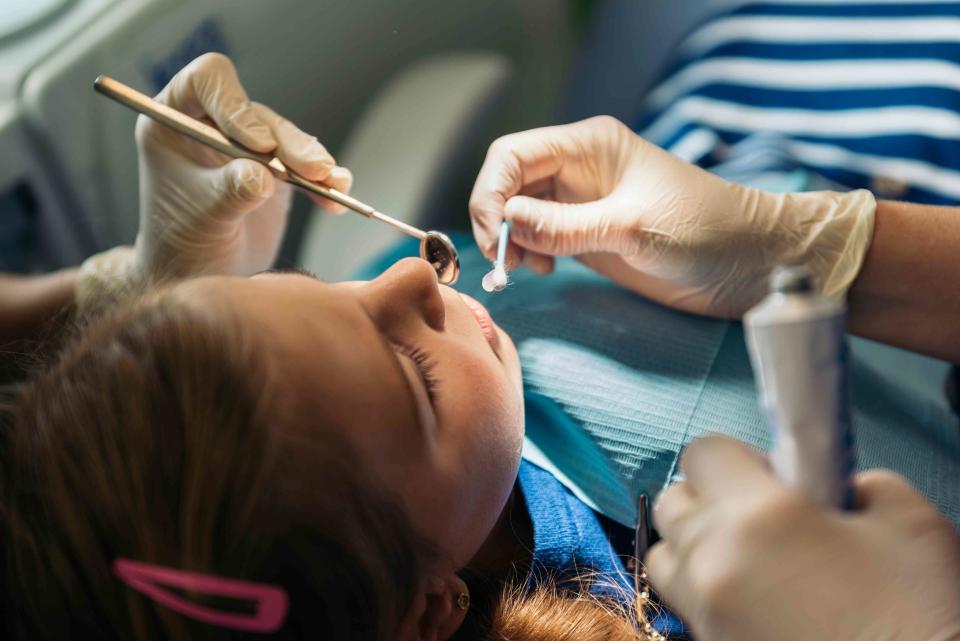Cavities In Baby Teeth? Why Some Kids Get Them and Others Don’t
While tooth decay is caused by bacteria, other factors can contribute to why your child does (or does not) get cavities. Read on to learn more.

Getty
The first time my daughter complained about tooth pain was just shy of her sixth birthday. We were talking and eating dinner, chatting about school and work. About “the day.” She was enjoying her meal: chicken, mashed potatoes, and applesauce. But suddenly, when she took a bite, she complained.
“My mouth hurts,” she said.
Initially, I dismissed her discomfort. I assumed she wanted to leave the table for more fun and engaging things, like her dolls or the TV. Plus, she was 5—and 5-year-olds don’t get cavities, right? Well, they can and she did. After lodging several more complaints, we went to the dentist where she discovered numerous holes in my baby’s teeth. My child had several cavities.
To say I was shocked would be an understatement. I didn’t know young children could get cavities, particularly in their baby teeth. I also didn’t understand how. We—well, she—brushed diligently, every morning and every night. But it turns out numerous factors can contribute to cavities.
Related:
Here’s everything you need to know about cavities in baby teeth, from what causes them to how they are treated.
What Causes Cavities in Baby Teeth?
Several factors can influence a child’s chances of developing cavities. According to Johns Hopkins Medicine, “tooth decay [and, in turn cavities are] caused by bacteria and other things. It [cavities] can happen when foods containing carbohydrates (sugars and starches) are left on the teeth. Such foods include milk, soda, raisins, candy, cake, fruit juices, cereals, and bread.” This means that cavities can be the result of poor oral hygiene and/or a diet high in these goods. However, there are other risk factors, too including:
Water supply with limited or no fluoride
Less saliva flow than normal
Genetics can also play a role.
How Common Are They?
Pediatric cavities are relatively common. By age five, for example, about 60 percent of U.S. children will have experienced tooth decay, a 2014 American Academy of Pediatric Dentistry report explains. But what’s the reason? Elizabeth Walton, clinical director of pediatrics at Risas Dental in Phoenix, Arizona, tells Parents it has a lot to do with the makeup of baby teeth.
“Cavities grow and spread in baby teeth faster than adult teeth because of the structure of the tooth,” says Dr. Walton. “The enamel (the hard outer shell of the tooth) is thinner on baby teeth. The nerve of the tooth is also bigger. This means bacteria can eat their way through the enamel faster on baby teeth than on adult teeth.”
What Is the Treatment for Cavities in Kids?
There are many different ways to treat cavities in baby teeth. My daughter, for example, had several fillings and two baby crowns. But what is the best method of treatment? According to Dr. Walton, it depends on the location and severity of the cavity.
“If the cavity lesion is very small and only in the enamel, it is possible to treat it with a very strong fluoride called silver diamine fluoride, or SDF,” says Dr. Walton. “If the cavity is larger, sometimes a filling will fix it. Even bigger still, a nerve treatment and crown might be necessary, and the biggest cavities sometimes require the tooth to be pulled.”
How Can Pediatric Cavities Be Prevented?
The best way to avoid cavities—in adult and baby teeth—is through preventative measures. “The goal of all pediatric dentists is to prevent traumatizing experiences surrounding dental care,” says Dr. Walton. “The best way to do this is to prevent the child from ever needing treatment. Therefore, regular home care is of utmost importance.”
“Starting at birth, wipe your baby's gums after feedings,” adds Dr. Walton. “Never put your baby to bed with milk in a bottle… and take your baby to the dentist, starting at 1 year or when their first tooth appears.”
Other ways to prevent cavities and tooth decay include:
Brushing. According to the American Academy of Pediatrics (AAP), this should be done twice a day for two minutes.
Flossing. While young children will not be able to floss their own teeth, you should add flossing to their dental care regimen when they are 2-years-old.
Limiting sweet or sticky foods. Candy, gummies, fruit snacks, and cookies, for example, should be limited. Other foods with sugar should be enjoyed in moderation.
Using a fluoride-based toothpaste. Fluoride, found in most toothpastes and in our water supply, is one of the most powerful ways to prevent tooth decay. Make sure you are using a fluoride-based toothpaste.
Drinking water which is fluoridated. Children benefit from drinking water with fluoride in it, according to the AAP. “If your tap water comes from a well or another non-fluoridated source, your child's doctor or dentist may want to have a water sample tested for natural fluoride content. If your tap water does not have enough fluoride, your child's doctor or dentist may prescribe a fluoride supplement. He or she may also apply fluoride varnish to your child's teeth to protect them from decay.”
That said, it’s important to note that—even with all of these preventative measures—your child may still get cavities. This is not a failure on your part or a shortcoming. Rather than lament the fact that they have cavities, focus on treatment. You can also step up care if and when you learn your child is prone to cavities.

